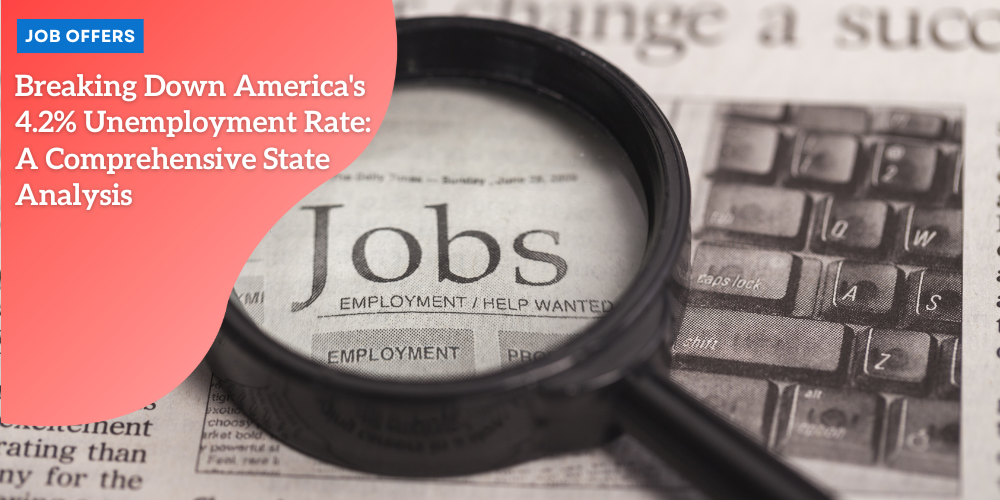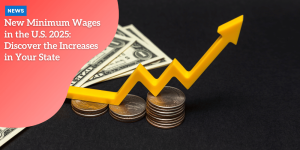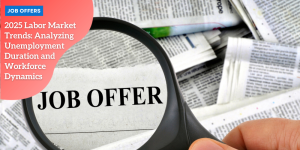Breaking Down America’s 4.2% Unemployment Rate: A Comprehensive State Analysis

The Current State of U.S. Employment: April 2025 Overview
April 2025 saw an encouraging addition of approximately 230,000 new jobs, surpassing economic forecasts.
Anúncios
Despite this positive job growth, the national unemployment rate saw an uptick to 4.2%, marking the highest level since October 2021.
While the overall job addition was a bright spot, it is worth noting that only six states recorded net job growth, leaving significant regional disparities.
Missouri and Pennsylvania were notable exceptions, with Pennsylvania adding nearly 29,000 new positions and Missouri leading in percentage growth with a 0.5% increase.
Anúncios
Despite the broader job gains, the rising unemployment rate and the regional divide signal underlying challenges.
With the national unemployment rate at 4.2%, disparities in state-level employment metrics hint at varying economic conditions and policy impacts across the U.S.
This data urges a deeper analysis of regional differences to understand better how the economic landscape affects employment across the country.
Anúncios
In the forthcoming sections, we will delve further into state-specific unemployment rates and job growth leaders to paint a clearer picture of America’s employment status in April 2025.
States with the Highest Unemployment Rates
Despite the addition of 230,000 new jobs in April 2025, the U.S. national unemployment rate has risen to 4.2%, shedding light on stark regional disparities.
Nevada stands out with the highest unemployment rate at 5.7%, a position it has held for five consecutive months.
Leading Unemployment States
Following Nevada, states like Washington DC (5.6%), Michigan (5.5%), California (5.3%), and Kentucky (5.2%) also report significantly high unemployment rates.
Notably, Michigan has seen the largest year-over-year increase in unemployment at 1.3%, escalating from 4.2% to 5.5%.
Mississippi follows close behind, witnessing a 1.1% rise from 2.8% to 3.9%.
Economic Challenges and Implications
These figures indicate that while some regions may be improving, others continue to struggle with economic hardships.
The persistent high unemployment in states like Nevada and Michigan suggests underlying economic challenges that may require targeted interventions.
As we move forward, understanding the factors contributing to these regional unemployment disparities will be crucial in addressing them effectively.
This analysis underscores the importance of localized economic policies and support systems that can cater to the unique needs of each state’s labor market.
Next, we’ll explore the factors contributing to the low unemployment rates in other states and how their strategies could potentially be employed in higher-unemployment regions to foster economic stability.
States with the Lowest Unemployment Rates
South Dakota: A Model of Workforce Stability
South Dakota has achieved a remarkable feat by maintaining the lowest unemployment rate in the nation at 1.8% for the 15th consecutive month.
This impressive consistency demonstrates the state’s robust economic framework, resilient industries, and proactive workforce development strategies.
Despite the national unemployment increase, South Dakota stands as a testament to what a stable and well-managed economy can achieve.
The Strong Performers: North Dakota and Vermont
North Dakota and Vermont are tied for the second-lowest unemployment rate at 2.6%, showcasing exemplary economic agility.
These states have leveraged their diverse industries and sustainable practices to keep their job markets strong.
Their continued focus on improving educational opportunities and fostering innovation has paid off, providing residents with ample employment options.
Montana: Leading the Way in Improvement
Unique among the states, Montana recorded a year-over-year decrease in unemployment, dropping from 3% to 2.7%.
This significant improvement reflects the state’s ongoing efforts to diversify its economy, invest in local businesses, and enhance workforce training programs.
Montana’s success story serves as an inspiration for other regions seeking to reduce unemployment rates amid national economic fluctuations.
Staying Below 3%: Hawaii and Nebraska
Rounding out the top performers are Hawaii and Nebraska, both maintaining unemployment rates of 2.9%.
These states have managed to sustain low unemployment through a mixture of tourism, agriculture, and technology sectors.
Their ability to create jobs across diverse industries has helped buffer the effects of broader national economic challenges.
The employment landscape in these top-performing states presents a stark contrast to regions struggling with higher unemployment rates.
Understanding these success stories can offer valuable insights into effective economic policies and strategies.
As we navigate the complexities of the current economic climate, these states provide practical examples of resilience and adaptability.

Job Growth Leaders: States Adding the Most Workers
April 2025 has shown that while the national unemployment rate may have risen, some states are experiencing substantial job growth, offering a nuanced picture of the country’s economic landscape.
Missouri and Pennsylvania emerged as key contributors to employment gains over the past month.
Missouri and Pennsylvania: Leading the Charge
Missouri led the nation in employment growth by percentage, boasting a 0.5% increase in its workforce.
This remarkable feat underscores the state’s resilience and its ability to attract new job opportunities.
Similarly, Pennsylvania made a significant impact by adding nearly 29,000 new positions, the highest numerical job gain among all states for the month.
Yearly Workforce Growth: Spotlight on Idaho and South Carolina
Over the past year, Idaho and South Carolina have demonstrated unparalleled workforce expansion rates.
Idaho’s workforce grew by 2.6%, while South Carolina followed closely with a 2.4% increase.
These percentages reflect robust economic activities and successful employment policies in these states, setting a high standard for others to follow.
Texas, Florida, and New York: Powerhouses of Employment
On a larger scale, Texas, Florida, and New York have also made their mark by adding the most jobs numerically over the past year.
Texas led with an impressive 14 million new positions, followed by Florida with 10.5 million, and New York with 9.5 million new workers.
These significant numbers highlight the economic strength and job creation capabilities of these states.
As the landscape of U.S. employment continues to evolve, it is crucial to observe how these dynamics unfold.
While job growth in certain states presents a positive outlook, disparities remain.
Considering the broader implications and potential regional disparities provides a comprehensive understanding of the current state of U.S. employment.
The Trump Administration’s Economic Impact
April 2025 marks the second full month of President Trump’s second term, a period characterized by job growth that has exceeded economic forecasts.
The U.S. added approximately 230,000 jobs in April, with Missouri and Pennsylvania among the six states recording net job growth.
Despite these gains, the national unemployment rate rose to 4.2%, its highest level since October 2021, reflecting regional economic disparities.
Federal Workforce Reductions and Employment Metrics
Planned federal workforce reductions have not yet appeared in the employment metrics.
These impending cuts are expected to influence public sector employment, but their impact is still uncertain.
The Trump administration’s focus on reducing the federal workforce has sparked discussions about the potential consequences for job markets across various states.
The Role of the Department of Government Efficiency
One of the most anticipated changes in the current administration is the establishment of the Department of Government Efficiency, led by Elon Musk.
This new department aims to streamline government operations and improve efficiency both in the public and private sectors.
It is expected that Musk’s innovative approaches could drive significant changes in employment patterns, though the extent and timing of these impacts remain to be seen.
Economic Uncertainty and Long-Term Effects
The Trump administration’s policies, including tariffs and trade adjustments, have created economic uncertainty.
Short-term effects include retaliatory measures, US treasury bond divestment, and stock market volatility.
Longer-term impacts may involve trade relationship realignments, supply chain changes, and increased onshoring of manufacturing.
These policies bring potential for long-term economic growth but also pose risks that need careful monitoring and assessment.
The regional disparities in unemployment rates hint at deeper economic issues that vary by state.
These include differences in industrial bases, policy approaches, and demographic factors.
Some states continue to prosper with sub-3% unemployment rates, while others grapple with rates above 5%.
As we look ahead, economic forecasts remain uncertain, particularly concerning tariffs and policy reviews.
The full assessment of current policy effectiveness will likely take months or years to accurately gauge.
Economic uncertainty alone can have chilling effects on trade, business investment, and overall growth.
Continued monitoring of the impacts and effectiveness of the Trump administration’s policies will be essential in addressing these disparities and fostering national economic health.
| 📌 Area of Impact | Short-Term Effects | Long-Term Implications |
|---|---|---|
| 💵 Financial Markets | Increased stock market volatility and divestment from U.S. Treasury bonds | Unstable investment climate affecting long-term funding and growth strategies |
| 🌍 Trade Relationships | Retaliatory tariffs from trade partners and disruption of existing agreements | Potential realignment of global trade networks and market diversification |
| 🏭 Supply Chains | Short-term confusion and rising costs due to sourcing instability | Shift to onshoring or new supplier networks, increasing operational complexity |
| ⚖️ Policy Stability | Sudden policy reversals and ongoing judicial challenges create confusion | Long-term uncertainty hampers strategic business planning and investment |
| 📉 Economic Confidence | Investor caution and business hesitation | Dampened innovation and reduced economic momentum over time |
Regional Disparities: Understanding the Geographic Employment Divide
Divergence in Employment Health Across States
The employment landscape in the United States showcases striking regional disparities.
While some states are thriving with unemployment rates lower than 3%, others are grappling with rates surpassing 5%.
For instance, South Dakota maintains the lowest unemployment rate at 1.8%, marking its 15th consecutive month at this level.
Conversely, Nevada struggles with the highest unemployment at 5.7%, a position it has held for five months.
Industrial Base’s Role
These disparities often reflect the industrial foundations of different regions.
States with diversified economies, such as South Dakota, North Dakota, and Vermont, which have strong sectors in technology, healthcare, and agriculture, tend to have more stable employment.
In contrast, states like Nevada and Michigan, heavily reliant on industries such as tourism and manufacturing, encounter more volatility during economic shifts.
Policy Approaches Matter
Differences in state policies and economic initiatives also contribute to these disparities.
States that invest in education, technology, and sustainable practices often build more resilient economies.
For example, states with the lowest unemployment rates have typically implemented progressive policies supporting small businesses and innovation.
Demographic Factors
Demographic factors also play a significant role. States with aging populations might face different employment dynamics compared to those with younger, growing workforces.
Similarly, states attracting more immigrant populations often see a boost in workforce numbers, influencing unemployment rates positively.
The mixed economic metrics highlight the complexity of the employment landscape across the U.S. and underscore the need for tailored approaches to economic policy and workforce development.
Understanding these disparities is vital for crafting effective, region-specific economic strategies moving forward.
Looking Ahead: Economic Forecasts and Uncertainties
As we look towards the future, the economic terrain appears to be cloaked in uncertainty.
The path ahead is particularly unclear with regards to tariffs and the judicial review of economic policies.
This ambiguity creates a cloud of nervousness that can dampen trade, business investment, and ultimately, economic growth.
The lingering uncertainty suggests that the full impact of evolving trade policies and workforce reductions will not be revealed for some time.
Economic forecasts are currently cautious, with many industries adopting a “wait-and-see” approach in light of potential policy shifts.
This atmosphere of unease could inherently slow business operations and investment, further complicating an already fragile recovery process.
Understanding the long-term effectiveness of current policies in this environment will demand patience.
A comprehensive assessment may take several months, if not years.
This extended timeline for evaluation stems from the complexity surrounding policy impacts.
It involves numerous variables, including the regional disparities and industrial dependencies seen across various states.
As we forge ahead, these uncertainties stand as a reminder that the coming months will likely be pivotal in reassessing and re-aligning economic strategies.
Both businesses and policymakers will need to stay agile yet hopeful for improving clarity and stability on the horizon.





